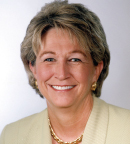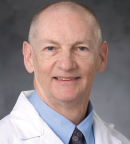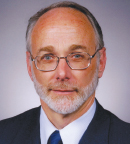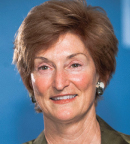Low-dose computed tomography (CT) screening for lung cancer in high-risk groups is moving into the clinic in the wake of its approval by the U.S. Centers for Medicaid & Medicare Services. That does not mean, however, the discussion is over. As low-dose CT moves from research to everyday practice, issues of implementation are coming to the fore. At the Prevent Cancer Foundation’s 13th annual Quantitative Imaging Workshop in Washington, DC, discussion focused on the need for quality assurance, standardization, and a national infrastructure to support low-dose CT screening.

Carolyn Aldigé
The Quantitative Imaging Workshops address issues from screening to measurement to policy and clinical practice. They bring together “oncologists, radiologists, measurement scientists, imaging experts, patient advocates, industry representatives, U.S. Food and Drug Administration (FDA) officials, and others—people who otherwise do not often find themselves in the same room,” said Carolyn Aldigé, President and Founder of the Prevent Cancer Foundation, which has convened the yearly workshops since 2004.
Building a National Infrastructure

James Mulshine, MD
One of the workshop’s main themes this year was how to ensure the delivery of high-quality screening. “Imaging is only as good as it is consistently good,” said James Mulshine, MD, of Rush University Medical Center, who chairs the workshop’s steering committee. “What is needed is good, accurate results across screening centers and types of equipment.”
Dr. Mulshine emphasized that this is especially important with lung cancer screening, where precise measurements are vital. In low-dose CT screening, CT scan images are relied on to determine whether a lung nodule is large enough to warrant surgical biopsy and to measure changes in nodule size between annual screenings. With quantitative imaging, “we have to be able to be sure it is real growth, not an artifact of the measurement technique,” he added. “It is doable but complicated—It requires a fair amount of discipline in image acquisition.”

Ricardo Avila
Giving an idea of how complicated it may be, Ricardo Avila, CEO of Accumetra LLC (an advanced imaging technology company), described his company’s Protocol Challenge, which recorded the measurements of identical objects at different screening sites using a variety of scanners. “We found a great deal of variability,” said Mr. Avila, who reported results so far from 26 different screening sites using 53 different scanners.
Accumetra used a variation on crowd sourcing to find volunteer participants, asking them to scan the objects (three rolls of scotch tape) and upload the results to the company’s website. In return, Accumetra offered free prototype image–quality feedback reports on the accuracy of the devices and protocols (settings) used.
CT image–quality reports continue to be available free of charge on the company’s website, said Mr. Avila. Participants receive an automated report within about 20 minutes of submitting their scans; they then can adjust their settings and submit new scans to see if there is improvement.
Clinical Trial Databases

David Yankelevitz, MD
Linked to the issue of quality assurance is the need for implementation data and systematic ways to collect data on low-dose CT screening. Databases associated with the two major U.S. trials of low-dose CT have already produced valuable findings, said David Yankelevitz, MD, of the Icahn School of Medicine at Mount Sinai in New York. Mount Sinai’s I-ELCAP (International Early Lung and Cardiac Action Program) trial has yielded data showing that false-positive results can be reduced by changing the threshold level for nodules in need of further assessment by just 1 mm.
He also noted that the database of the National Lung Screening Trial (NLST), along with the I-ELCAP database and a review of world literature, confirmed that nonsolid nodules in the lungs grow slowly and can be monitored rather than immediately removed.

Daniel Sullivan, MD
The workshop’s focus on data continued in a breakout session that discussed development of a national infrastructure for implementing quantitative imaging–quality processes. One recommendation was to pursue the establishment of a “cloud-based” database that would be easily accessible online. The database would be interactive, so sites could contribute data and receive feedback as demonstrated with the Protocol Challenge, said Mr. Avila, who co-chaired the group with Daniel Sullivan, MD, of the Quantitative Imaging Biomarkers Alliance (QIBA).
The group also recommended that each patient study include a separate high-resolution reconstructed data set, even if no nodule is visible to the human eye. With sophisticated quantitative imaging software, Mr. Avila explained, these high-resolution data sets will be machine-readable. “We’re basically saying that radiologists don’t need to look at every image in every series, as is now generally thought to be required, because we have advanced image analysis software exists that can use the higher-resolution data to help radiologists perform better detection and measurement tasks if a finding is present.”
Other recommendations included the integration of quality assessment for lung cancer with that for chronic obstructive pulmonary disease and coronary artery disease as well as meetings with patient and professional groups, including the American College of Radiology, the Radiological Society of North America, the Lung Cancer Alliance, the FDA, and others.
Moonshot Opportunity

Thomas Baer, PhD

Laurie Fenton Ambrose
Another major focus of the workshop centered on the opportunities stemming from the White House Cancer Moonshot initiative, which includes early detection research as one of its priorities. In a breakout session, Thomas Baer, PhD, of Stanford University, who heads the National Photonics Initiative Cancer Moonshot Taskforce, and Laurie Fenton Ambrose, who heads the Lung Cancer Alliance, led a discussion of how best to catalyze a coordinated effort by industry, academia, health-care providers, and patient advocates. Aside from the chance of federal funding, Dr. Baer added, the Moonshot initiative was an opportunity for the field of photonics to come together on priorities and goals.
The breakout group agreed on three priorities: (1) to expand clinical studies with existing noninvasive imaging technologies and companion molecular tests for early detection of cancer; (2) to expand funding for the development of new approaches for early detection and treatment of cancer, where these technologies are needed; and (3) to provide the resources to develop a network for an IT medical infrastructure available to U.S. health-care providers and consumers.
The third recommendation includes not only quantitative imaging data, but also analysis tools and molecular biomarker data, Dr. Baer clarified in an interview. The need to include molecular data stems from the potential of imaging to help guide therapeutic choices. “What we’re really trying to do is develop the ability to use quantitative imaging in conjunction with molecular markers to guide the selection of pharmaceuticals for early cancers,” he stated.
The National Photonics Initiative published a white paper technology roadmap on June 29, coinciding with the Cancer Moonshot Summit in Washington.
Another theme of the workshop was the potential of quantitative imaging to accelerate research in other tobacco-related diseases, including coronary artery disease and chronic obstructive pulmonary disease. That question, along with others about precision measurement, quality standards, and infrastructure, can be expected to receive more attention in the years ahead, predicted Ms. Aldige. “The research phase is not over by any means,” she added. ■
Disclosure: Ms. Aldigé, Ms. Fenton Ambrose, Dr. Mulshine, and Dr. Baer reported no potential conflicts of interest. Dr. Yankelevitz is named inventor on a patent application with Cornell Research Foundation and is entitled to a share of any compensation, he is also an equity owner in Accumetra.


